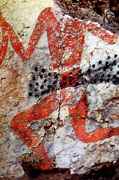Catalhoyuk at Çumra, 45 kilometers (28 miles) south of Konya, is a fascinating Neolithic site in Central Anatolia dating from the 10th-8th millennium BC, which makes it one of the world's oldest towns. Archaeologists have determined that holes in the roofs of the mud houses were the entrance doors. Ankara's Museum of Anatolian Civilizations houses the famous temple-house (reconstructed), along with mother-goddess Cybele figures, obsidian and clay objects and Neolithic frescoes from the original site.
 The discovery of this Neolithic settlement, the largest and most complex known in the world until the discovery of Gobeklitepe site, was among the great archaeological finds of the 1960s. Here was evidence of one of the first agricultural - based settlements and a place where women may have had a central leadership role. Found amid the ruins were wooden, metal, and earthenware artifacts, as well as murals, bas-reliefs, and sculptures that depicted systems of early belief. The archaeologists suddenly abandoned their work after five years and the ruins were left exposed. Not until 1993 was remedial conservation work undertaken on site.
The discovery of this Neolithic settlement, the largest and most complex known in the world until the discovery of Gobeklitepe site, was among the great archaeological finds of the 1960s. Here was evidence of one of the first agricultural - based settlements and a place where women may have had a central leadership role. Found amid the ruins were wooden, metal, and earthenware artifacts, as well as murals, bas-reliefs, and sculptures that depicted systems of early belief. The archaeologists suddenly abandoned their work after five years and the ruins were left exposed. Not until 1993 was remedial conservation work undertaken on site.
Open trenches had allowed walls and associated art to disintegrate. Previous Watch listing elicited funds for urgent backfilling and shoring up of walls, but much still needs to be done. The Catalhoyuk Friends association and other organizations raised some money to build a roof on top to protect the wall paintings. Another major threat results from the severe drop in the water table due to a local irrigation project. The Turkish Water Authority (DSI) has suggested digging a water channel around the ruins. This must be done on an emergency basis to save the artifacts still undiscovered within the buried city. Future plans call for a conservation facility, museum, and visitor center.
Çatalhöyük was listed in 1996 as one of the 100 most endangered sites of the world by the World Monuments Fund and as of July 2012 it's listed in the UNESCO's World Cultural Heritage List.
The site can be visited all year around, but it is advised to visit it during the excavations, usually between April and October every year. The excavations are sponsored by many local and foreign companies including Boeing, Shell, Yapi Kredi, Koç etc.
On the way south to Beysehir you can stop at Eflatun Pinari next to the lake to see this unusual Hittite monumental fountain. The excavation of the site is on its way.
Several interesting Seljuk buildings are scattered around lovely Beysehir, on the shores of Turkey's third largest lake, Beysehir Lake. In the southwestern region of the lake is the pristine wilderness of Lake Beysehir National Park. Among the monuments are the Esrefoglu Mosque and Medrese, and the Kubad-Abad Summer Palace across the lake. Another medieval palace stands on Kizkalesi Island, opposite the Kubad-Abad Palace. Haci Akif Island also offers relaxation and recreation to visitors.

